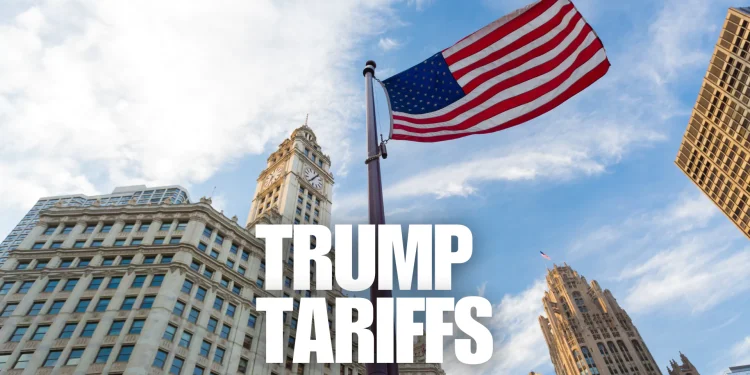In 2025, tariffs are back in the spotlight. With Donald Trump returning to the White House and reigniting his trade war policies,and the financial markets haven’t been nosier. His new wave of tariffs—targeting everything from Chinese tech to European luxury goods—has sent ripples through global supply chains, investor sentiment, and long-term economic strategies.
If you’re interested in learning how these 2025 tariffs may affect long-term investments you’ve come to the correct place. Let’s take a closer look at the new tariffs, their immediate impacts, and—above all—what they mean for your investing portfolio.
What Are the 2025 Tariffs About?
In his second term, Trump has doubled down on his “America First” approach, this time unveiling a fresh set of tariffs aimed at reducing America’s reliance on foreign goods and bolstering domestic manufacturing. The 2025 tariffs include:
- A 25% tariff on Chinese technology products, particularly semiconductors, robotics, and artificial intelligence tools.
- 15% tariffs on European luxury goods, such as automobiles, wine, and fashion items.
- A 10% tariff on imported consumer electronics from countries like South Korea and Japan.
Trump has justified these tariffs as necessary to protect American jobs, cut the trade deficit (which, as of 2024, hit $1 trillion), and punish nations he claims are engaging in unfair trade practices. However, the global economy isn’t what it was in 2018, and the effects of these policies are far more complex this time around.
The Immediate Market Reaction
If you’ve been watching the markets over the past few months, you’ve likely noticed the volatility. Stock indices like the S&P 500 and the NASDAQ initially dipped following the announcement of the tariffs, as investors scrambled to assess their impact.
Once again, companies reliant on global supply chains are feeling the heat. For example:
- Tesla announced that the new tariffs on imported batteries from China would increase production costs by 20%, potentially delaying the rollout of their next-generation EVs.
- Nike reported that tariffs on Asian-manufactured goods could cost the company an additional $400 million annually, forcing them to raise prices.
On the flip side, some domestic industries—like steel, manufacturing, and agriculture—are seeing a temporary boost as the government pushes “Buy American” policies. U.S. Steel Corp, for instance, saw its stock price rise 15% in the first quarter of 2025.
But as we’ll see, the real story lies in the long-term consequences for global trade and investment strategies.
The Long-Term Impact on Investing
Above is a live heatmap of the S&P 500
1. Global Supply Chains Are Facing a Second Reshuffle
The 2025 Trump tariffs have accelerated a trend that began back in 2018: the restructuring of global supply chains. Many companies had already started diversifying their operations away from China due to the first wave of tariffs and the disruptions caused by the COVID-19 pandemic.
Now, with even higher tariffs in place, this diversification is speeding up. Countries like India, Vietnam, and Mexico are emerging as key alternatives for manufacturing.
Take Apple, for example. The tech giant has announced plans to move 30% of its iPhone production to India by 2026, citing both rising costs in China and the unpredictability of U.S. trade policy. Similarly, General Motors has expanded its production facilities in Mexico to avoid tariffs on Chinese automotive parts.
For investors, this means paying close attention to companies with flexible, diversified supply chains. Businesses that cling too tightly to outdated trade models may struggle to remain competitive in the coming years.
2. Higher Costs Are Shrinking Margins
Tariffs are essentially taxes, and someone has to pay. In many cases, it’s the companies importing goods—and by extension, their investors—who bear the brunt of these costs.
For example, Intel, which relies heavily on imported semiconductors from Asia, recently reported that the new tariffs could reduce its profit margins by 5% to 7% in 2025. Retailers like Walmart and Target are also feeling the squeeze, as higher costs for consumer electronics and household goods threaten to eat into their already thin margins.
For long-term investors, this raises an important question: how well can a company adapt? Businesses with strong pricing power—those that can pass costs onto consumers without losing market share—are better positioned to survive in a tariff-heavy environment.
3. Emerging Markets Are Seeing a Boost
Here’s a silver lining: while the Trump tariffs are tough on China, they’ve been a boon for other emerging markets. Countries like Vietnam, Malaysia, and India are stepping in to fill the void left by China’s diminished export power.
For instance, Vietnam’s exports to the U.S. have already increased by 28% year-over-year in early 2025, according to data from the Peterson Institute for International Economics. India, too, is reaping the benefits, particularly in the tech and pharmaceutical sectors.
This shift presents a unique opportunity for investors. Emerging market ETFs focused on Southeast Asia or South Asia could offer significant long-term growth potential—especially as these regions continue to attract foreign investment.
4. Commodities Are Back in the Spotlight
The 2025 Trump tariffs have also reignited volatility in the commodities market. China’s retaliatory tariffs on U.S. agricultural products—particularly soybeans and corn—have disrupted global supply chains yet again.
In response, American farmers are pivoting to new markets, but the transition hasn’t been smooth. For example, soybean exports to Brazil and Argentina are up 15% in Q1 2025, but prices remain volatile due to shifting global demand.
For investors, commodities have always been a double-edged sword: high risk but potentially high reward. If you’re considering this space, look into commodity-focused funds or hedging strategies to manage the inherent risks.
The Bigger Picture: Protectionism on the Rise
One of the most significant long-term consequences of the 2025 Trump tariffs is the growing trend toward protectionism—not just in the U.S., but globally. Countries are increasingly prioritizing their domestic economies, leading to a fragmentation of global trade networks.
For investors, this means that the old rules of globalization no longer apply. Companies with localized supply chains and a strong domestic presence are likely to outperform in this new era of economic nationalism.
What Should Long-Term Investors Do in 2025?
If you’re feeling unsure about how to navigate the current investing landscape, don’t worry—you’re not alone. Here are a few strategies to help you stay ahead:
- Focus on Resilient Sectors: Look for industries less affected by tariffs, such as healthcare, renewable energy, and technology. These sectors often have strong growth potential and can weather trade disruptions better than manufacturing or retail.
- Diversify Your Portfolio: Consider investing in emerging markets like Vietnam, India, or Mexico, which are benefiting from global supply chain shifts.
- Watch Margins Closely: Companies with strong margins and the ability to adapt to rising costs are better positioned for long-term success.
- Consider ETFs or Index Funds: If you’re unsure where to invest, ETFs focused on specific sectors or regions can help spread your risk while still capturing growth opportunities.
- Stay Informed: Tariff policies can change quickly. Keep an eye on trade news and adjust your investment strategy as needed.
Conclusion | Trump Tariffs Affecting Long-Term Investing
Trump’s 2025 tariffs aren’t just about trade—they’re about reshaping the global economic order. For long-term investors, this presents both challenges and opportunities. The key is to stay flexible, informed, and focused on the bigger picture.
Remember: markets thrive on uncertainty. While tariffs may disrupt old patterns, they also create new opportunities for growth. Whether it’s investing in emerging markets, resilient companies, or alternative assets, there’s always a way to adapt—and thrive—in a changing world.
So, how are you adjusting your portfolio in 2025? Are you embracing the opportunities, or sitting this one out?













